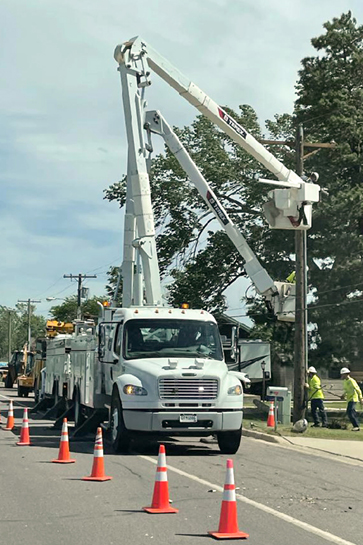5 Things That Contribute to Quick Response After a Storm
 Whether it’s rain, wind, snow, ice or a combination of all of the elements, utility companies need to have a storm response plan in place so they can dispatch crews quickly to restore services. An extensive response plan includes ensuring equipment and people are ready to go at a moment’s notice. Here are five steps to make sure you are ready.
Whether it’s rain, wind, snow, ice or a combination of all of the elements, utility companies need to have a storm response plan in place so they can dispatch crews quickly to restore services. An extensive response plan includes ensuring equipment and people are ready to go at a moment’s notice. Here are five steps to make sure you are ready.
1. Preventative Maintenance
An efficient maintenance program will reduce the amount of time it takes for a utility company to deploy its fleet to the field in an emergency and will also help reduce the work for service technicians and mechanics during peak operating intervals. And because storm work usually occurs in bad weather conditions, a routine program will help alleviate field repairs. When major storms are predicted, utilities should review which equipment will be due for maintenance soon and be proactive with getting the equipment ready. Storm work will rapidly put hours on the machines compared to normal work.
2. The Right Tires
Inspecting and replacing tires is usually part of a routine maintenance program. Spending some time to check tire conditions before dispatching a truck for storm work is crucial. Depending on the time of year, crews are facing icy and snow-packed roads, or debris after high winds, tornados and hurricanes. The type of storm will dictate what’s needed to make sure a truck’s tires are safe for travel.
Plenty of tread is important for rain, sleet, snow and ice.
High flotation tires can operate more effectively in wet and muddy conditions.
If warranted, fit tires with snow chains, and make sure crews know how to put them on to prevent potential damage to the vehicle.
When a storm creates and eaves lots of debris, a tire service shop can chemically treat tires so that trucks can continue to drive even on a flat tire.
3. Storm Supplies
Before deploying, replace any consumable or wear items that might be getting worn or be used, such as jib ropes, jumper cables, grounding tools, electric tools, box cables, and extensions.
Make sure field technicians are carrying the proper DOT documentation.
Consider communication backup in case cell phone towers are out, such as two-way or CB radios.
During major outages, additional supplies may be needed. A leading electric utility in the State of Alabama has a 24-ft storm trailer equipped with parts, supplies and a dedicated living quarter for mechanics. The trailer is stocked year-round with inventory needed for a particular season. Examples include check valves, pressure switches, wiper blades, de-icer and antifreeze, generators, light towers and propane heaters.
4. Setup Reminders
In cold weather conditions, it’s important to give trucks and equipment extra time to warm up, and before turning a truck off, the driver should bleed the air tanks to prevent freezing of the airlines and valves.
Positioning a vehicle can also be more challenging. In icy and snowy conditions, the operator should avoid setting up on snow or ice if at all possible. Snow and ice may need to be removed down to the bare ground to gain traction to prevent sliding. Putting down mats, rock, gravel or sand will also help. Also, wet and muddy conditions may cause the truck and outriggers to sink, which could reduce stability.
5. Take Care of the Crew
Field technicians may be working 12-to-14-hour days in harsh weather conditions. Make sure they have the right kind of clothing for the weather, reflective gear to increase visibility, and be sure they are eating and hydrating properly.
Prepare your storm readiness plan appropriate for the start of the different storm seasons, which can contribute to faster response times and reduce operational risks.

.png?sfvrsn=cfc0900d_0)